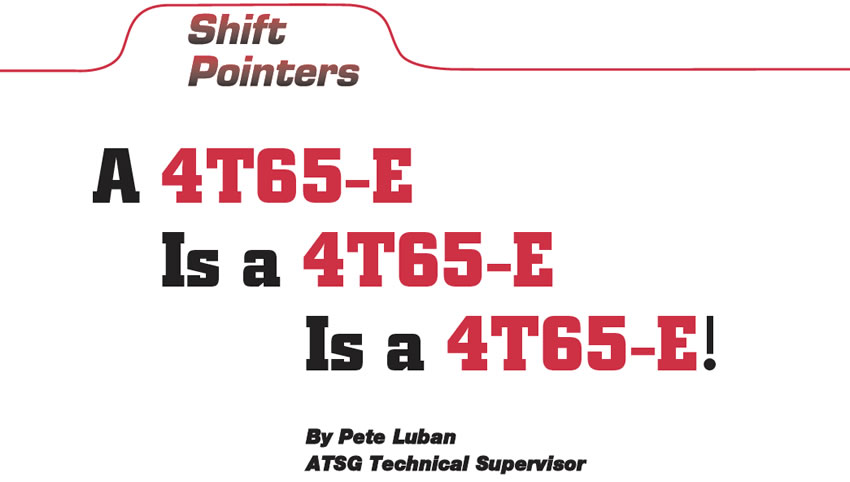A Bouquet of Hybrids
Honda hit the road first with its gas-engine/electric-motor combo called the Insight, but it was Toyota that pioneered the “Hi Voltage Battery” technology and used it in its Prius vehicle. Ford broke ground by producing the first hybrid SUV with its 2003 Ford Escape. Ford also has plans in the works in which it will use the latest hybrid-electric-vehicle technologies with an advanced new fuel cell to produce the zero-emissions Ford Focus. Prototypes begin in 2004. Other manufacturers soon will have vehicles of environmentally friendly design available for purchase here as well. So it’s another technology that the auto-repair and rebuilding industry needs to prepare for.

A 4T65-E Is a 4T65-E Is a 4T65-E!
I don’t think I have anything weird for you this month, just some differences in 4T65-E applications requiring special overhaul-kit items that you need to be aware of when it’s on your bench.

E4OD/4R100 Safety Alert
The concern addressed in the bulletin is that the wiring from the overdrive switch may not be routed properly and may come into contact with a steering-column-cover mounting screw and cause a short. This short will blow the #17 fuse.

The Upshift-Delay Dilemma
Several 1989-1995 Mercedes vehicles using the 722.3 or 722.4 transmission employ a device called the “upshift-delay vacuum actuator.” For this article, I will refer to it as the UDVA.

Rescue Ranger
Many times after an initial scan of the computer system, you find an electrically related solenoid code. If you’re lucky, a new solenoid fixes it, or maybe there’s a problem with the internal wiring – not so bad to fix these problems.
But then there are the times that these items do not take care of the problem. That usually means these days that an external wiring problem is causing that solenoid code.

Necessary Tools
One of the responsibilities of a reputable transmission shop is to prevent problems before they occur. Checking the quality of the parts that are going into the transmission is one way to achieve this. Checking the hardness of the metal parts is an important part of this process.

Stuck On, Stuck Off or Just Plain Stuck
With the introduction of OBD-II, a ton of additional codes became available (remember, we were always asking for more information). In some instances, these new codes were a great help because they did not just indicate a short or an open circuit but also pointed to parameters that were out of range, which included both mechanical and electrical problems.

Even Failsafe Is Subject to Change
Since then, technology has leaped forward at a vicious pace, not breaking for breath. And with this technological race among the “Big 3” manufacturers (U.S., Japan and Europe) comes the need for various computer strategies. Failsafe is one of those strategies that has experienced a change.

Transmission Orifices
It may seem obvious initially, but when you’re talking about transmission orifices, size does matter. What may be surprising, though, is how significant a difference in vehicle performance small changes in orifice diameters can make. This becomes important when you’re considering modifications to separator-plate holes (see Figure 1) or cup-plug orifices (see Figure 2) during a rebuild.

Another Fantastic Ford Fable
A 1997 Ford E 250 van equipped with a 4.2-liter engine and a 4R70W transmission comes into the shop with a complaint of falling out of fourth gear into third at highway speeds. In local traffic, however, the transmission acts like a C6 with a stuck governor; it remains in second gear as you come to a stop and “dunks” down into first gear.

Is Your 4WD Explorer Neutralizing?
But inside the transfer case closest to the transmission is the transfer direct-clutch drum that the sealing rings just love to dig into. The severity of the wear determines the degree of the complaint; i.e., delayed engagements, slipping or no movement. Technicians often misdiagnose this problem by blaming the transmission for the problem when all along it has been in the transfer case.

Load-Testing Solenoid Circuits
The last thing I want to do is put you to sleep with an article on performing electrical tests and Ohm’s Law. What I want to show here is something that I think is really exciting: load-testing solenoid circuits with an ammeter! Using an ammeter and a calculator can save time, LOTS OF TIME. How would you like to check the power distribution, ignition switch, external and internal wiring, solenoids, computer and computer grounds without putting the vehicle on a lift or even raising the hood?

